|
Hot tours
Site map
Main menu
Hotels booking
Airlines Schedule
Tajik air company schedule
Somon air schedule
Uzbek Havo Yullary - Uzbekistan Airline Schedule
Kazakh air company schedule - Almaty ALA Flights Airport Schedule
Kyrgyz aie company schedule - Kyrgyzstan Bishkek Central Asia Airport - flight schedule
Turkmenistan airlines Schedule - Satans tour Turkmenistan airlines Schedule
Search
|
Dushanbe
Welcome to Dushanbe  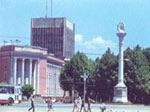
DUSHANBE - THE CAPITAL OF TAJIKISTAN
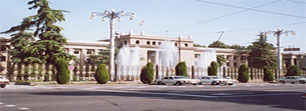
DUSHANBE - is the capital of the republic of Tajikistan with the population of more than 600 thousand peoples and majoring more than twenty embassies of foreign countries. The city is multinational and present time is considered to be the scientific, cultural and industrial developed center of the country. There are museums, theatres, universities, hotels and around the city there were preserved some ancient historical monuments like Hissar fortress and etc..
In ancient times such towns as Boukhara, Samarkand, Penjikent were the centers of the development of Zoroastrian culture. After the invasion of Arabians Zoroastrism collapsed into pieces to Zerafshan and Pamir. Ancient towns of Great Silk Road as Samarkand, Boukhara, Khiva, Merv, Penjikent, Khujand, Osh were the places of vital, economic interests of many countries of the world. This part of the world was the crossroads of caravan roads connecting North-South, East-West, and they led to China, India, Rome and to Europe.
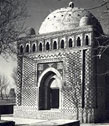 Ismoili Somoni Monument 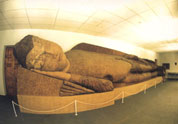
Buddha sleep
 cultural
Name : Dushanbe
Population : c. 1000,170
Language: Tajik (Persian)
Area code: 992 37
Transportation: Dushanbe is connected to Termez and Tashkent in Uzbekistan, by rail way and to Kulyab,
Kurqan-tepa, and Khorog, the administrative center of Gorno-Badakhshan Pamir, by road. Due to the
mountainous terrain of the region, travel by plane and helicopter often is preferred to travel by car . More
Post: DHL Tajikistan
Accommodation: Click here
Map: Road map
Orientation: Dushanbe is divided into four administrative zones: Somoni, Sino, Markazi, Rohi ohan Varzob, a suburb of Dushanbe, used to serve as one of the prominent recreation areas for the former Soviet Union. At the present time, the city serves as both the administrative center of the Republic of Tajikistan and the republic's largest industrial and cultural center. Dushanbe has two main bazaars: Barakat and Shomansur (or Green bazaar). A third bazaar in the region of the new micro rayon’s is exclusive to that population. During the summer, the bazaars teem with vegetables, fruits, flowers, and people. In winter, they are all but deserted. Bread, meat, and dried fruits are about all one can buy.
A wonderful modern Opera & Ballet theater and a number of art-related institutes, museums, and studios, all centered in the city of Dushanbe. The city also houses the Firdowsi Library, a major library with an impressive collection of medieval Islamic manuscripts. The main points of interest all lie on, or close to, Prospect Rudaky which runs from the railway station in the south to the bus station in the north. As well as the principal mosque , this area boasts a synagogue that dates back to the late 19th century, a Russian church and a columned opera house.
Don’t forget visiting a Tajik market because, while you will find souvenirs, your senses will be pleasantly bombarded and, unlike in many developing countries, no-one will harass you to buy anything . Lose yourself in the enormous market on the road west from Dushanbe to the old Hissar Fort, where women in traditional Tajik attire of long, psychedelically colored dresses and men in embroidered skullcaps sell everything from cotton (one of Tajikistan’s main crops) to vegetables, jewelers, carpets and furniture The Tajik traditional Tea houses Rohat (Choykhona ) with beautiful decoration . Walking down the streets of Dushanbe, a number of special features attract your attention. A prominent one is the teahouse or the Choykhona. You realize you are near a Choykhona when you hear the music filling the air and when you see the many colorful benches that invite the customers to take a few minutes of rest, drink tea and listen to the gossip of the day.
In addition to tea and sweets, kabob and rice, are often also served. Other features in the city include the National Museum of Antiquities of Tajikistan and Unified Museum , situated just north of the railway station in Ploshchad Ainy(square Ainy), which has stuffed snow leopards and Marco Polo sheep amongst its exhibits. The ethnographic museum is on street Somoni, not far from the Hotel Tajikistan.
The delightful clothes of the men and women from the villages (kishlaks) is another interesting feature. Men wear the traditional joma (a knee-long jacket) tied at the waist with a colorful miyonband (kerchief). Their toqi (skullcap) with its paisley design, distinguishes the wearers by region. Women wear a kurta, made of soft, colorful, bright silk, and a shalvar (long pants) with decorative cuffs (sheraz). Women also wear hats with their national costume. The hats,
especially those imported from Boukhara and Badakhshan Pamir, are either embroidered or decorated with precious stones. Village women mostly wear colorful rosaries (scarf) tied in the back and worn in a decorative manner more like a hat than for cover as a veil. Farmers and herders wear a special heavy boot over their usual shoes. The older generation wear long Islamic cloaks and turbans. Many of the older people wear beards; they are referred to as aksakal’s (white beard) or muy sapheads (Tajik, lit. white hair).
|
Last news
2017-03-08 VIST US AT ITB BERLIN 20172014-03-15 Pamir & mountain travel co.in ITB 20142012-12-06 Super Star Aquarius docks at Chan May port! |

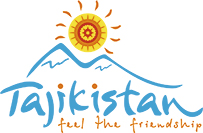
|
Hot tours
Site map
Hotels booking
Search
|
Dushanbe
Welcome to Dushanbe  
DUSHANBE - THE CAPITAL OF TAJIKISTAN

DUSHANBE - is the capital of the republic of Tajikistan with the population of more than 600 thousand peoples and majoring more than twenty embassies of foreign countries. The city is multinational and present time is considered to be the scientific, cultural and industrial developed center of the country. There are museums, theatres, universities, hotels and around the city there were preserved some ancient historical monuments like Hissar fortress and etc..
In ancient times such towns as Boukhara, Samarkand, Penjikent were the centers of the development of Zoroastrian culture. After the invasion of Arabians Zoroastrism collapsed into pieces to Zerafshan and Pamir. Ancient towns of Great Silk Road as Samarkand, Boukhara, Khiva, Merv, Penjikent, Khujand, Osh were the places of vital, economic interests of many countries of the world. This part of the world was the crossroads of caravan roads connecting North-South, East-West, and they led to China, India, Rome and to Europe.
 Ismoili Somoni Monument 
Buddha sleep
 cultural
Name : Dushanbe
Population : c. 1000,170
Language: Tajik (Persian)
Area code: 992 37
Transportation: Dushanbe is connected to Termez and Tashkent in Uzbekistan, by rail way and to Kulyab,
Kurqan-tepa, and Khorog, the administrative center of Gorno-Badakhshan Pamir, by road. Due to the
mountainous terrain of the region, travel by plane and helicopter often is preferred to travel by car . More
Post: DHL Tajikistan
Accommodation: Click here
Map: Road map
Orientation: Dushanbe is divided into four administrative zones: Somoni, Sino, Markazi, Rohi ohan Varzob, a suburb of Dushanbe, used to serve as one of the prominent recreation areas for the former Soviet Union. At the present time, the city serves as both the administrative center of the Republic of Tajikistan and the republic's largest industrial and cultural center. Dushanbe has two main bazaars: Barakat and Shomansur (or Green bazaar). A third bazaar in the region of the new micro rayon’s is exclusive to that population. During the summer, the bazaars teem with vegetables, fruits, flowers, and people. In winter, they are all but deserted. Bread, meat, and dried fruits are about all one can buy.
A wonderful modern Opera & Ballet theater and a number of art-related institutes, museums, and studios, all centered in the city of Dushanbe. The city also houses the Firdowsi Library, a major library with an impressive collection of medieval Islamic manuscripts. The main points of interest all lie on, or close to, Prospect Rudaky which runs from the railway station in the south to the bus station in the north. As well as the principal mosque , this area boasts a synagogue that dates back to the late 19th century, a Russian church and a columned opera house.
Don’t forget visiting a Tajik market because, while you will find souvenirs, your senses will be pleasantly bombarded and, unlike in many developing countries, no-one will harass you to buy anything . Lose yourself in the enormous market on the road west from Dushanbe to the old Hissar Fort, where women in traditional Tajik attire of long, psychedelically colored dresses and men in embroidered skullcaps sell everything from cotton (one of Tajikistan’s main crops) to vegetables, jewelers, carpets and furniture The Tajik traditional Tea houses Rohat (Choykhona ) with beautiful decoration . Walking down the streets of Dushanbe, a number of special features attract your attention. A prominent one is the teahouse or the Choykhona. You realize you are near a Choykhona when you hear the music filling the air and when you see the many colorful benches that invite the customers to take a few minutes of rest, drink tea and listen to the gossip of the day.
In addition to tea and sweets, kabob and rice, are often also served. Other features in the city include the National Museum of Antiquities of Tajikistan and Unified Museum , situated just north of the railway station in Ploshchad Ainy(square Ainy), which has stuffed snow leopards and Marco Polo sheep amongst its exhibits. The ethnographic museum is on street Somoni, not far from the Hotel Tajikistan.
The delightful clothes of the men and women from the villages (kishlaks) is another interesting feature. Men wear the traditional joma (a knee-long jacket) tied at the waist with a colorful miyonband (kerchief). Their toqi (skullcap) with its paisley design, distinguishes the wearers by region. Women wear a kurta, made of soft, colorful, bright silk, and a shalvar (long pants) with decorative cuffs (sheraz). Women also wear hats with their national costume. The hats,
especially those imported from Boukhara and Badakhshan Pamir, are either embroidered or decorated with precious stones. Village women mostly wear colorful rosaries (scarf) tied in the back and worn in a decorative manner more like a hat than for cover as a veil. Farmers and herders wear a special heavy boot over their usual shoes. The older generation wear long Islamic cloaks and turbans. Many of the older people wear beards; they are referred to as aksakal’s (white beard) or muy sapheads (Tajik, lit. white hair).
|
Last news
2017-03-08 VIST US AT ITB BERLIN 20172014-03-15 Pamir & mountain travel co.in ITB 20142012-12-06 Super Star Aquarius docks at Chan May port!hotels
trekking in Fann mountain
transportations
National meal
|







































